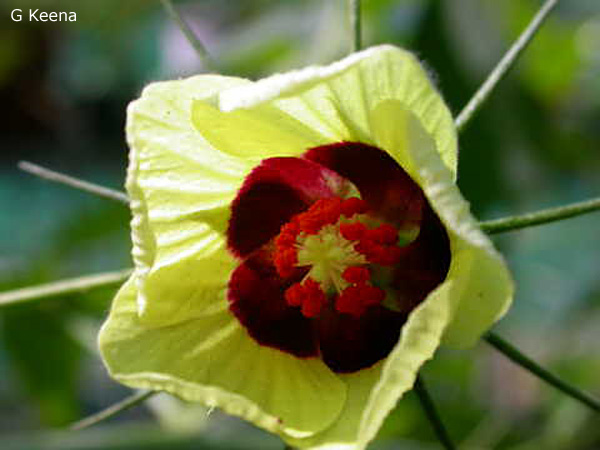General Description:
Hibiscus is a genus which is well known in horticulture through the many exotic species and cultivars, principally Hibiscus rosa-sinensis which has thousands of registered cultivars. Overall there are more than 300 Hibiscus species which occur mainly in tropical and sub-tropical regions. Australia has about 40 native species, most of which are endemic. There are also a number of closely related genera in Australia with Hibiscus-like flowers. These include Abelmoschus, Alyogyne, Gossypium, Howittia and Lagunaria.
Hibiscus pentaphyllus is a small shrubby annual to about 1.5 metres high by a similar width. The leaves are up to 70 mm long by 50 mm wide and deeply lobed. The flowers are bright yellow with a central maroon or brown blotch. They are about 75 mm in diameter of typical hibiscus shape.
In common with most Hibiscus species, the individual flowers last only 1-2 days but new flowers continue to open over a long period, generally in summer and autumn. The flowers are followed by hairy seed capsules containing a number of seeds.
Hibiscus pentaphyllus is not in widespread cultivation but it has potential as a colourful annual for tropical and sub-tropical areas. It should perform best is a sunny position with well drained soils.
In common with the exotic hibiscus cultivars, hibiscus beetles may be a problem. These can be controlled by placing white ice cream containers with detergent water among the hibiscus plants and putting fresh water and detergent in the containers every few days.
Propagation from seed is relatively easy and no special pretreatment is needed although germination will be faster if seed is abraded or soaked before planting. Cuttings should also strike readily.
For further information on Australian Malvaceae, see the Australian Native Hibiscus and Hibiscus-like Species website.
Thanks to Jim Purdie for the hint on using detergent water to trap hibiscus beetles.

Hibiscus pentaphyllus
Photo: Geoff Keena

Seed pods of
Hibiscus pentaphyllus
 Australian Native Plants Society (Australia)
Australian Native Plants Society (Australia)